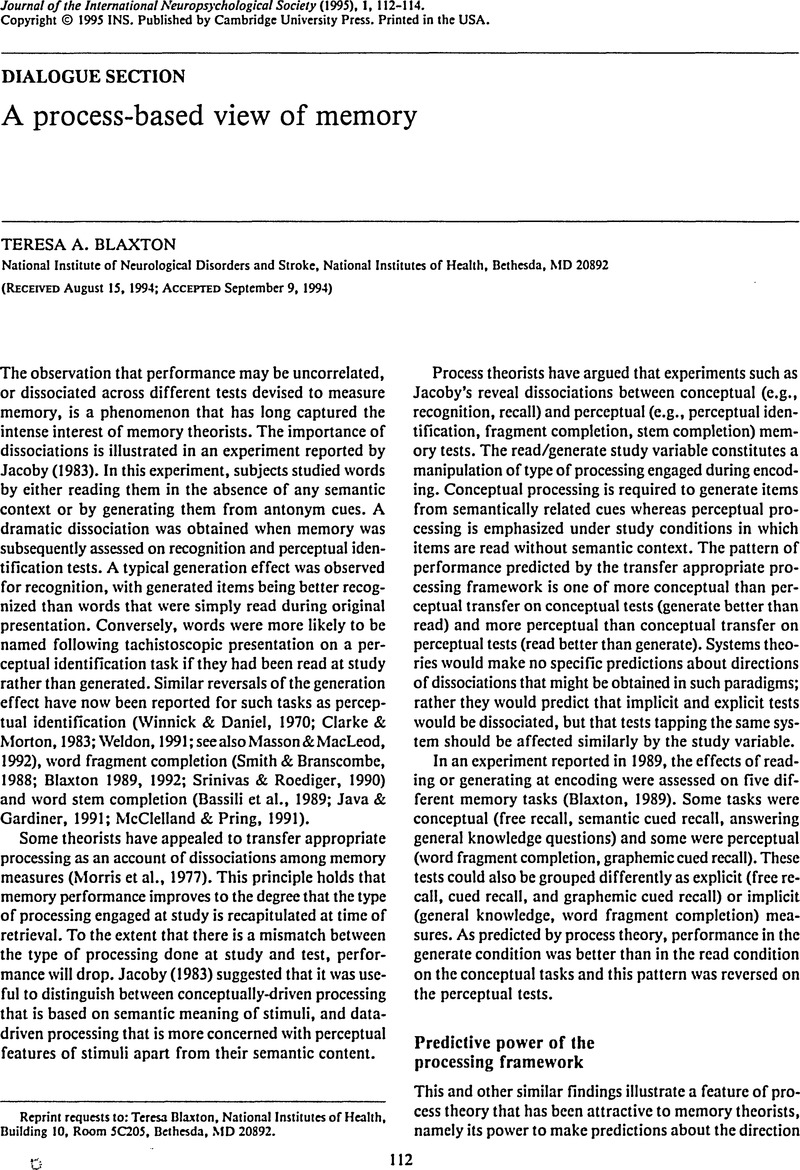Crossref Citations
This article has been cited by the following publications. This list is generated based on data provided by Crossref.
Maki, Pauline M.
1995.
Is implicit memory preserved in alzheimer's disease? implications for theories of implicit memory.
Aging, Neuropsychology, and Cognition,
Vol. 2,
Issue. 3,
p.
192.
Rich, Jill B.
Bylsma, Frederick W.
and
Brandt, Jason
1996.
Item Priming and Skill Learning in Amnesia.
Journal of Clinical and Experimental Neuropsychology,
Vol. 18,
Issue. 1,
p.
148.
Rajaram, Suparna
1997.
Basal forebrain amnesia.
Neurocase,
Vol. 3,
Issue. 6,
p.
405.
Glisky, Elizabeth L.
1998.
The Other Side of the Error Term - Aging and Development as Model Systems in Cognitive Neuroscience.
Vol. 125,
Issue. ,
p.
261.
Koutstaal, Wilma
Schacter, Daniel L.
Verfaellie, Mieke
Brenner, Carolyn
and
Jackson, Eric M.
1999.
PERCEPTUALLY BASED FALSE RECOGNITION OF NOVEL OBJECTS IN AMNESIA: EFFECTS OF CATEGORY SIZE AND SIMILARITY TO CATEGORY PROTOTYPES.
Cognitive Neuropsychology,
Vol. 16,
Issue. 3-5,
p.
317.
Drury, Joanne L.
Kinsella, Glynda J.
and
Ong, Ben
2000.
Age differences in explicit and implicit memory for pictures..
Neuropsychology,
Vol. 14,
Issue. 1,
p.
93.
Rajaram, Suparna
and
Coslett, H.Branch
2000.
New Conceptual Associative Learning in Amnesia: A Case Study.
Journal of Memory and Language,
Vol. 43,
Issue. 2,
p.
291.
Gupta, Prahlad
and
Cohen, Neal J.
2002.
Theoretical and computational analysis of skill learning, repetition priming, and procedural memory..
Psychological Review,
Vol. 109,
Issue. 2,
p.
401.
Watkins, Philip C.
2002.
Implicit memory bias in depression.
Cognition & Emotion,
Vol. 16,
Issue. 3,
p.
381.
Veselis, Robert A.
2003.
Neural Mechanisms of Anesthesia.
p.
21.
Yeates, Keith Owen
and
Enrile, Benedicta G.
2005.
Implicit and Explicit Memory in Children With Congenital and Acquired Brain Disorder..
Neuropsychology,
Vol. 19,
Issue. 5,
p.
618.
Boehm, Stephan G.
and
Sommer, Werner
2012.
Independence of Data-Driven and Conceptually Driven Priming.
Psychological Science,
Vol. 23,
Issue. 9,
p.
961.
Perrin, D.
and
Rousset, S.
2014.
The Episodicity of Memory.
Review of Philosophy and Psychology,
Vol. 5,
Issue. 3,
p.
291.
Finn, Bridgid
and
Tauber, Sarah K.
2015.
When Confidence Is Not a Signal of Knowing: How Students’ Experiences and Beliefs About Processing Fluency Can Lead to Miscalibrated Confidence.
Educational Psychology Review,
Vol. 27,
Issue. 4,
p.
567.



